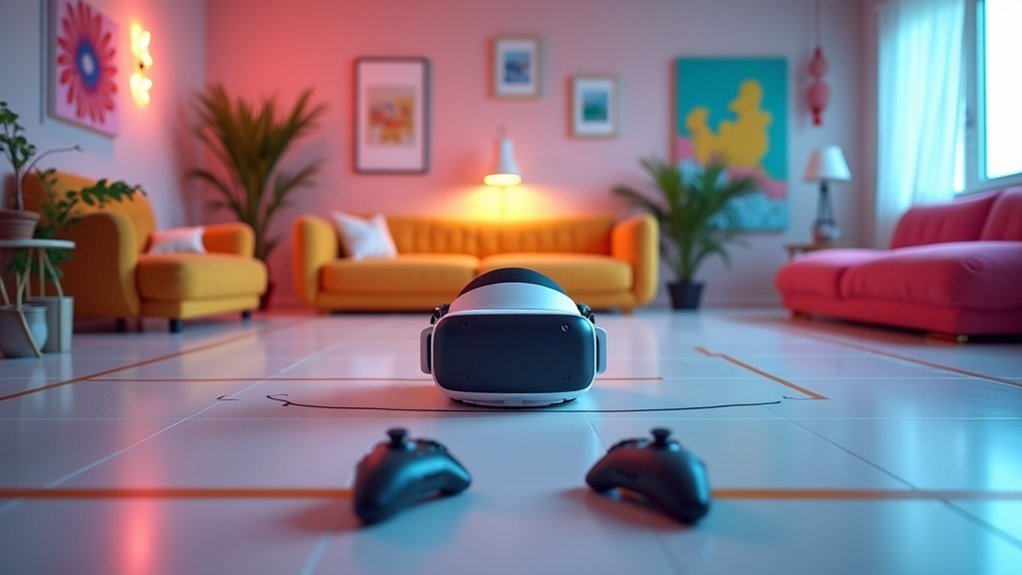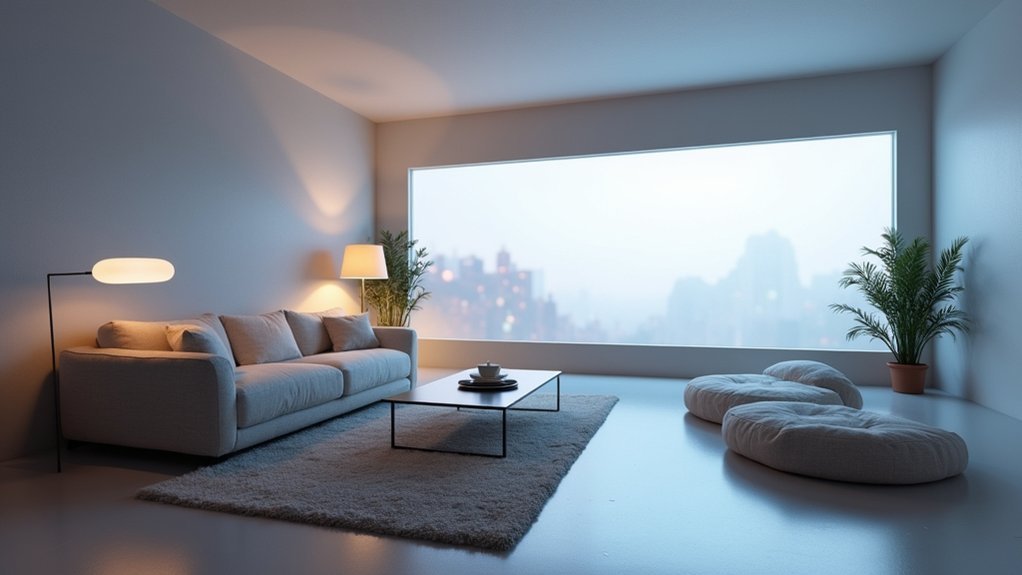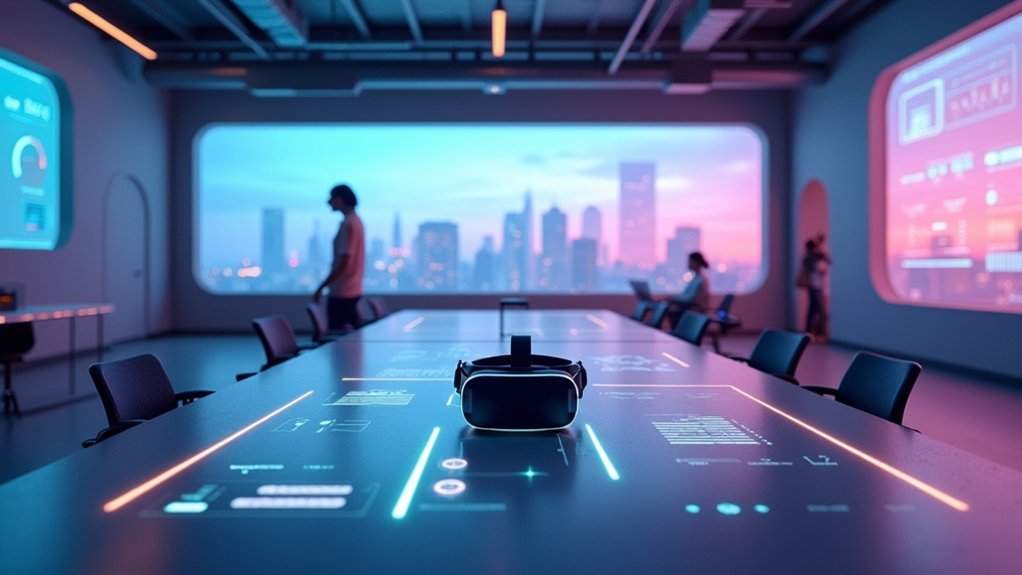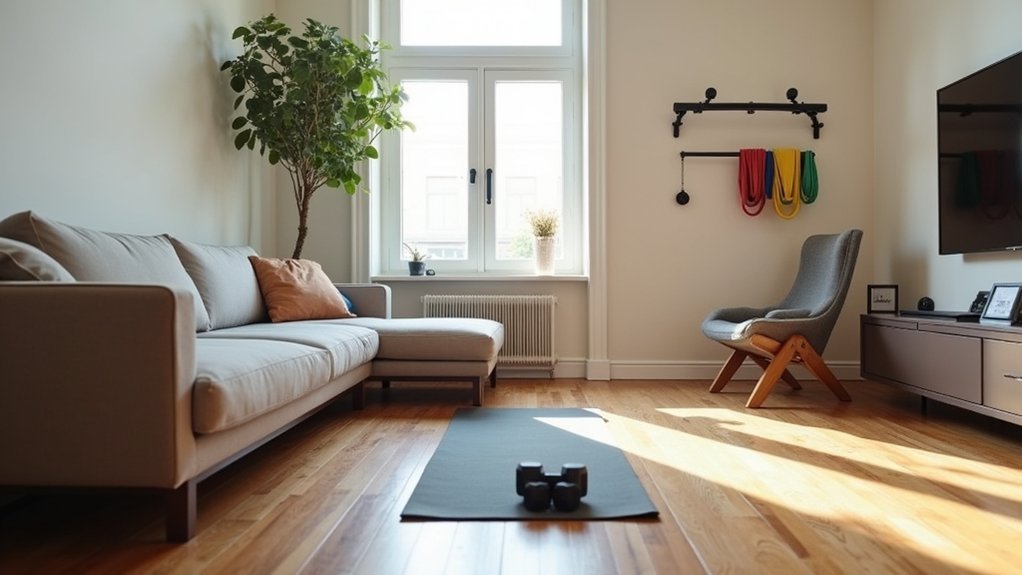Your VR space needs proper planning because inadequate room setup leads to tracking failures, safety hazards, and broken immersion. You’ll need a minimum 2.5×2.5 meter obstacle-free area with proper ceiling height to prevent collisions. Poor base station positioning, reflective surfaces, and cluttered environments cause constant interruptions during gameplay. Without cleared boundaries, appropriate lighting, and non-slip flooring, you’re risking falls and equipment damage. Proper planning guarantees seamless virtual experiences and transforms your space into an optimized VR environment.
Understanding Room Scale VR Space Requirements

When setting up your room-scale VR system, you’ll need to dedicate at least 2.5 x 2.5 meters (8.2 x 8.2 feet) of clear floor space to move naturally within virtual environments.
Room-scale VR requires a minimum 2.5 x 2.5 meter clear space for safe, natural movement during virtual experiences.
This VR space must remain completely obstacle-free since you’ll crouch, reach, and walk around during gameplay. Your tracking system requires adequate ceiling height too—controllers like the Vive’s larger ones can easily hit low ceilings during active sessions.
Remove furniture, decorations, and anything that could create potential hazards. You don’t want to trip over coffee tables or bump into walls while immersed.
Consider that room-scale VR encourages full-body movement, so plan accordingly. The clearer and larger your dedicated area, the more comfortable and safe your virtual experiences will be.
Essential Components for Optimal VR Performance
You’ll need to carefully select hardware that meets VR’s demanding performance requirements while ensuring your tracking system accurately captures every movement.
Your setup must include a high-quality headset, VR-ready PC or console, precise motion controllers, and properly positioned base stations or sensors.
These components work together to create the foundation for smooth, immersive experiences that won’t leave you frustrated with lag or poor tracking accuracy.
Hardware Selection Fundamentals
Building a successful VR space planning setup starts with selecting the right hardware components that’ll deliver smooth, immersive experiences. Your VR headset choice directly impacts visual quality and comfort during extended sessions. High-end options like the HTC Vive and Oculus Rift provide superior resolution and ergonomic designs.
Your VR setup requires careful consideration of these essential hardware specifications:
- VR-ready PC or console with powerful GPUs and sufficient RAM for lag-free performance
- Motion controllers that enable natural, intuitive interaction within virtual environments
- Base stations or sensors for accurate movement tracking and spatial awareness
- Quality audio systems paired with ergonomic furniture for enhanced comfort
Each component works together to create your immersive experience, so don’t compromise on quality when building your ideal VR space.
Tracking System Setup
Achieve flawless VR experiences by mastering your tracking system setup, the foundation that determines how accurately your movements translate into the virtual world. You’ll choose between inside-out tracking using headset cameras or outside-in tracking with external sensors for enhanced precision. Base stations, particularly 2.0 models, expand your play area up to 10×10 meters for truly immersive VR experiences.
| Component | Placement | Coverage |
|---|---|---|
| Base Stations | Corner positioning | 10×10 meters |
| Height | 2 meters elevated | Downward angled |
| Surface Type | Non-reflective | Minimal interference |
| Calibration | Regular maintenance | Multiple headsets |
| Tracking Method | Inside-out/Outside-in | Enhanced precision |
Position sensors opposite each other in corners, minimize reflective surfaces, and calibrate regularly for peak performance during multiplayer sessions.
Space Configuration Requirements
Three critical elements form the foundation of any high-performing VR setup: adequate physical space, proper hardware configuration, and enhanced environmental conditions.
Your space for VR directly impacts the quality of your immersive experience, making careful planning essential.
To create an ideal play area, you’ll need these four essential components:
- Minimum 2.5 x 2.5 meter room-scale area for safe movement and interaction
- Complete VR equipment suite including headset, VR-ready PC, motion controllers, and base stations
- Obstacle-free zone with marked boundaries using tape for accident prevention
- Bright, diffuse lighting to eliminate shadows that interfere with tracking systems
Don’t overlook comfort elements like ergonomic furniture, which reduce fatigue during extended sessions.
Your tracking system’s accuracy depends on these foundational requirements working together seamlessly.
Measuring and Preparing Your Physical Play Area
Setting up your VR system starts with accurately measuring your available space to guarantee you’ve got enough room for safe, immersive gameplay.
You’ll need approximately 2m x 1.5m for Vive systems or 1.5m x 2m for Oculus Rift. Measure height clearance carefully to prevent controller collisions with ceilings during active sessions.
Clear all obstacles from your designated play area, including furniture, decorations, and anything you might trip over or strike during movement.
Remove furniture, decorations, and potential tripping hazards from your VR play area to prevent accidents during movement.
Mark boundaries with tape to establish visible limits and position base stations strategically for ideal tracking accuracy.
Ensure your space has bright, diffuse lighting to prevent shadows that confuse tracking systems.
Choose flat surfaces with good traction to avoid slips.
These preparations create a safe foundation for immersive VR experiences.
Lighting and Environmental Considerations

Ideal lighting transforms your VR experience from frustrating to flawless by ensuring your tracking system can accurately monitor your every movement.
Bright, diffuse illumination eliminates shadows that confuse sensors, while minimizing reflections that break immersion.
Your environmental setup requires careful attention to these key factors:
- Install bright, even lighting throughout your play area to eliminate tracking dead zones
- Choose hard flooring surfaces over carpets to maintain tracking accuracy and prevent slips
- Maintain strict cleanliness standards by removing all clutter, cables, and potential hazards from the floor
- Verify adequate ceiling height to accommodate reaching, jumping, and crouching movements safely
These environmental considerations directly impact your safety and the quality of your VR sessions, making proper preparation essential.
Flooring and Safety Requirements for VR Movement
Your VR space’s flooring forms the foundation of safe movement during immersive experiences.
You’ll need to select surfaces that provide ideal traction while implementing systems that prevent dangerous slips and falls.
Smart tactile reference systems can help you maintain spatial awareness without breaking immersion or compromising your safety.
Optimal Floor Surface Types
When you’re establishing a VR play area, the flooring beneath your feet becomes a critical safety component that directly impacts your movement and tracking accuracy.
Your flooring surface choice can make the difference between seamless gameplay and potential injury.
The best options for VR movement include:
- Hardwood floors – Provide excellent traction while allowing smooth sliding movements.
- Tile surfaces – Offer reliable grip and easy maintenance for active sessions.
- Laminate flooring – Delivers consistent performance with good slip resistance.
- Textured rubber mats – Add tactile feedback for enhanced ground perception.
You’ll want to avoid carpeted areas since they hinder movement and increase tripping risks.
A completely flat surface guarantees accurate tracking without confusing your VR system.
Regular cleaning keeps your play area hazard-free for maximum safety.
Preventing Slips and Falls
Beyond selecting the right surface material, implementing thorough slip and fall prevention measures transforms your VR space into a secure environment for dynamic gameplay.
You’ll need to maintain spotless floors by removing all debris, cables, and obstacles that could cause unexpected slips during immersive sessions. Clear your play area’s walls and surrounding zones completely, ensuring nothing interferes with your full range of motion during active gameplay.
Consider placing a textured mat within your play area boundaries. This provides valuable tactile feedback, helping you track your position while reducing slip risks on smooth surfaces.
Don’t overlook height clearance requirements—you’ll need adequate overhead space for crouching, jumping, and reaching movements. Insufficient clearance creates dangerous hazards that greatly increase your risk of serious falls and ceiling impacts.
Tactile Ground Reference Systems
While visual cues dominate VR experiences, tactile ground reference systems serve as your physical anchor to reality during immersive gameplay. These textured surfaces provide essential feedback about your position, helping you navigate your play area safely without constantly checking your real-world location.
Implementing effective tactile reference systems requires careful consideration:
- Install non-slip surfaces like rubber mats to prevent accidents during intense movement sequences.
- Choose durable, easy-to-clean materials that withstand perspiration and frequent use.
- Create defined boundaries with textured tape or mats to maintain spatial awareness.
- Arrange proper lighting to minimize reflections that interfere with tracking accuracy.
Your tactile ground reference systems work silently in the background, ensuring you stay oriented while maximizing freedom of movement in virtual worlds.
Base Station Positioning and Tracking Setup
Two key factors determine the success of your VR tracking system: base station positioning and environmental enhancement.
You’ll want to mount your base stations at opposite corners of your play area, approximately 2 meters high, angling them downward for maximum coverage. This diagonal placement guarantees ideal tracking accuracy throughout your entire space.
Base Stations 2.0 expand your possibilities, supporting play areas up to 10m x 10m for truly immersive experiences. Proper calibration becomes critical when running multiple headsets simultaneously in shared spaces.
Base Stations 2.0 deliver expansive 10m x 10m tracking zones, but demand precise calibration for multi-headset setups.
Environmental factors greatly impact performance. Remove or cover reflective surfaces like mirrors, glass tables, and glossy artwork.
These create tracking interference that’ll disrupt your VR sessions. Clean walls and matte finishes work best for maintaining consistent sensor communication.
Furniture Arrangement and Obstacle Management

Once you’ve optimized your base station setup, you’ll need to tackle the physical layout of your VR space. Proper furniture arrangement and obstacle management are vital for creating a safe, dedicated space that enhances your VR experience.
Effective VR space planning requires these essential steps:
- Clear a minimum 6×6 foot area for unobstructed movement during gameplay.
- Use furniture sliders – fabric ones for hard surfaces, plastic for carpeted areas.
- Choose modular furniture that you can quickly reconfigure for VR sessions.
- Remove fragile items and potential hazards from your play area.
You’ll want to regularly assess your layout to guarantee it remains functional as your equipment and gameplay preferences evolve.
This proactive approach prevents accidents and equipment damage.
Audio Setup and Comfort Enhancements
Creating an ideal audio environment transforms your VR experience from merely visual to truly immersive. You’ll want to invest in high-quality VR-compatible headphones or speakers that deliver clear, realistic soundscapes matching your virtual environment. Noise-canceling features block external distractions, letting you focus completely on your virtual world.
Your audio setup requires strategic placement—position speakers for surround sound effects and guarantee headphones fit comfortably to prevent discomfort during extended sessions.
Don’t overlook comfort enhancements beyond audio. Adding ergonomic furniture like chairs with lumbar support prevents fatigue during longer VR sessions. Place a mat or rug in your play area to track your position while providing a comfortable surface for standing and moving, greatly boosting your overall immersion and enjoyment.
Testing and Optimizing Your VR Configuration
After completing your audio and comfort setup, you’ll need to systematically test every component of your VR configuration to confirm peak performance and safety.
Testing your VR space thoroughly prevents accidents and guarantees maximum tracking accuracy.
Here’s how to enhance your configuration:
- Verify play area dimensions – Confirm you have at least 2m x 1.5m of clear space for safe movement and interaction during gameplay.
- Position tracking sensors correctly – Mount base stations approximately 2 meters high, angled downward for maximum tracking precision.
- Check software compatibility – Update VR software regularly to maintain hardware compatibility and fix performance-disrupting bugs.
- Test environmental conditions – Use bright, diffuse lighting on hard surfaces while removing obstacles that could cause accidents.
Frequently Asked Questions
What Is the Recommended Space for VR?
You’ll need at least 6×6 feet for basic room-scale VR, but we’d recommend 8×10 feet for ideal movement. Don’t forget ceiling clearance – you’ll want enough height for raised arms.
What Makes a Good VR Environment?
You’ll need bright, diffuse lighting to prevent tracking shadows, obstacle-free flooring with good traction, adequate height clearance for movement, and strategically placed sensors. Ergonomic furniture and quality audio enhance your overall experience.
What Do I Need for a Full VR Setup?
You’ll need a high-quality VR headset, VR-ready PC or console, motion controllers, and base stations for tracking. Don’t forget comfortable furniture, good audio systems, and proper lighting to enhance your experience.
What Is the Purpose of Setting up the Environment in Unity for VR Development?
You’ll set up Unity’s VR environment to create immersive experiences with proper lighting, optimize performance for smooth frame rates, enable realistic physics interactions, and configure spatial settings that match your specific VR hardware requirements.





Leave a Reply